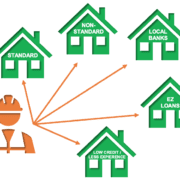Investor Mortgage Report 5.5.2020
Categories: Blog Posts, Resources, Tips, Trends Tuesday

Refinancing may have just become more expensive for both rate and lower LTVs.
Wow, what is this? The powers that be are still messing with our beautiful lending world. It’s not a shock that government officials seem more focused on getting votes at the cost of property owners and mortgage companies, encouraging tenants not to pay rents and not lending a hand with evictions.
What We Know:
Mortgage rates are so low right now (in the mid 2’s for owner-occupied, and low 3’s for investors) that still-employed buyers should be running out and buying homes left and right. After all, the number one reason buyers purchase is that they can fit the payment into their monthly budget. We should be seeing mortgage companies throwing money out to everyone. We should see buyers buying and investors refinancing (increasing that cashflow without adding more properties.)

So why isn’t that happening?
In short- our government is hard at work wreaking havoc in the lending markets, making it harder for all of us to get a loan, especially refinances.
Sure, it sounds good in theory: Allow anyone who wants to defer a payment or 4 during an economic crisis to do so, without proving any reason based on financial hardship.
How does this impact us all? Glad you asked.
If a lender helps someone out and refinances them and they decided to go directly into forbearance, (yes, people WERE doing cash-out refinances with the plan of deferring payments to take advantage of the government’s kindness,) that lender cannot sell or move that loan off of their books to those that service FHA, VA, Conventional loans, etc, unless they want to take pay a huge fee. So, they decide to hold the loans, thus filling up their lending bucket.
So what happens next? The lenders don’t want to take a chance that a percentage of people are going to take advantage of this opportunity, so they raise the cost of refinancing for everyone. On top of that, they will start lowering the LTVs (loan-to-value ratios,) making the box for traditional financing harder for all.
Yes, obviously those that need mortgage forbearance should be able to use it, but it’s the ones who are not in financial need that are making these numbers grow, creating more costly financing for us all.
Let’s look at the numbers from an article from MBA.com from the end of April:
Key findings of MBA’s Forbearance and Call Volume Survey – April 13-19, 2020
- Total loans in forbearance grew relative to the previous week (from 5.95% to 6.99%.) In comparison, only 0.25% of all loans were in forbearance for the week of March 2.
- By investor type, Ginnie Mae loans grew the most relative to the prior week: from 8.26% to 9.73%.
- The share of Fannie Mae and Freddie Mac loans in forbearance increased relative to the prior week: from 4.64% to 5.46%.
- The share of other loans (e.g. private-label securities and portfolio loans) in forbearance increased relative to the prior week: from 6.43% to 7.52%.
- Forbearance requests as a percent of servicing portfolio volume (#) dropped relative to the prior week: from 1.79% to 1.14%.
What You Can Do:
Keep up with your payments if you’re able. The more of us that are paying on time and in full, the quicker the lenders will start to relax and start loaning again. Everyone wins.











